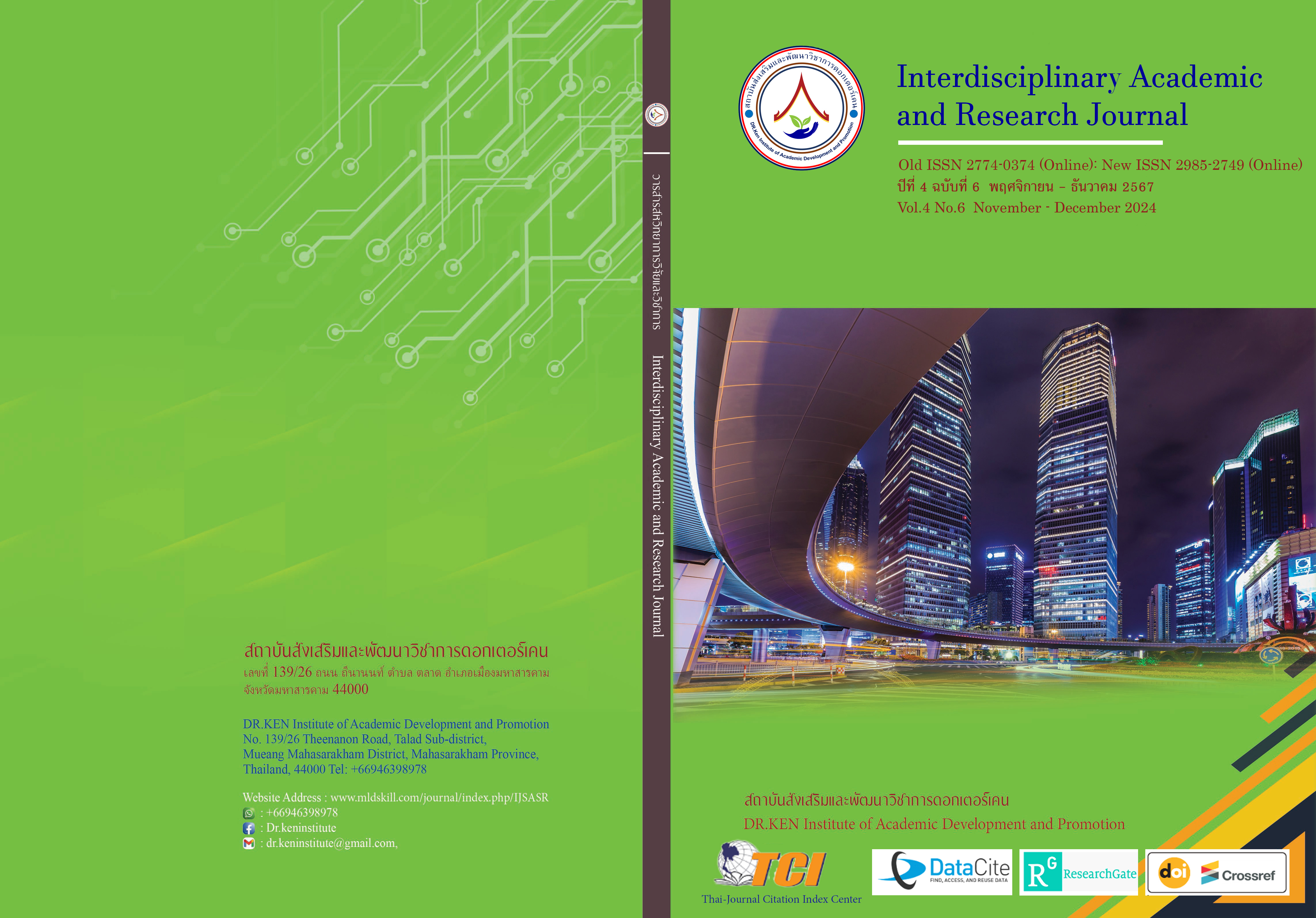Early Childhood Small Muscle Development Meet the Art of Creating from Natural Materials
DOI:
https://doi.org/10.60027/iarj.2024.276892Keywords:
Creative Arts, Natural Materials, Small Muscles, Early ChildhoodAbstract
Background and Aims: Early childhood education is the development of children from birth to 6 years old. This period is critically important in human life according to developmental psychology, as it is considered the most crucial stage of development. Comprehensive development is based on nurturing and promoting learning processes that are natural and age-appropriate for each child. The focus is on ensuring children develop in all four aspects: physical, emotional-social, and intellectual abilities. Developing fine motor skills and interpersonal coordination are fundamental for various activities of children. This research aims to compare the fine motor skills of early childhood before and after participating in creative art activities using natural materials.
Methodology: The target group for this study includes both boys and girls in Kindergarten 2/1, currently studying in the second semester of the academic year 2567 at Udonvithaya School under the Private Education Promotion Commission, totaling 15 individuals. The tools used in this research include plans for creative art activities using natural materials and a test to measure fine motor skills, aimed at enhancing the efficient and effective development of children's fine motor skills. Statistical analysis used includes mean values, standard deviations, and percentages.
Results: (1) The percentage of early childhood children's small muscles used both before and after the experiment when they were arranged into creative art projects using natural materials was 65.03 percent. and it equaled 96.88 percent following the experiment. After the experiment, the score was more useful than it was initially. And (2) Planning artistic endeavors using organic materials. After the experiment, the early childhood children's ability to use small muscles was higher than it was before in every way. The skills of dexterity in using small muscles, the ability to control the use of small muscles, and hand-eye coordination are listed in descending order.
Conclusion: The use of small muscles increased by a significant 31.85% when early childhood children were involved in creative art projects using natural materials, indicating significant improvements in motor skills after the experiment. Moreover, the incorporation of organic materials into artistic design improved their hand-eye coordination, dexterity, and control over the use of small muscles, demonstrating a thorough development of these vital abilities.
References
กระทรวงศึกษาธิการ. (2546). คู่มือหลักสูตรการศึกษาปฐมวัย พุทธศักราช 2546. กรุงเทพฯ : โรงพิมพ์คุรุสภา.
กระทรวงศึกษาธิการ. (2551). การเลี้ยงดูเด็กก่อนวัยเรียน 3–5 ขวบ. กรุงเทพฯ : โชติสุขการพิมพ์.
กระทรวงศึกษาธิการ. (2555). แผนพัฒนาการศึกษาของกระทรวงศึกษาธิการ ฉบับที่สิบเอ็ด พ.ศ. 2555 - 2559. กรุงเทพฯ : กระทรวงศึกษาธิการ.
กระทรวงศึกษาธิการ. (2560). หลักสูตรการศึกษาปฐมวัย พุทธศักราช 2560. กรุงเทพฯ: โรงพิมพ์คุรุสภา.
กระทรวงศึกษาธิการ. (2561). คู่มือหลักสูตรการศึกษาปฐมวัย พุทธศักราช 2560 สำหรับเด็ก อายุ 3-6 ปี.กรุงเทพฯ: ชุมชนสหกรณ์การเกษตรแห่งประเทศไทย.
กุลยา ตันติผลาชีวะ. (2551). การจัดกิจกรรมการเรียนรู้สำหรับเด็กปฐมวัย. กรุงเทพฯ: เบรน-เบสบุ๊ค.
ทิศนา แขมมณี. (2553). ศาสตร์การสอนองคความรูเพื่อการจัดกระบวนการเรียนรูที่มีประสิทธิภาพ. กรุงเทพฯ : จุฬาลงกรณมหาวิทยาลัย.
เบญจา แสงมะลิ. (2550). การพัฒนาเด็กปฐมวัย. กรุงเทพฯ : เมธีทิปส์.
โรงเรียนอุดรวิทยา. (2565). การศึกษาพัฒนาการการใช้กล้ามเนื้อมัดเล็กของเด็กอนุบาลชั้นปีที่ 2 ปีการศึกษา 2565 ของโรงเรียนอุดรวิทยา. สำนักงานคณะกรรมการการส่งเสริมการศึกษาเอกชน.
วรวรรณ เหมชะญาติ. (2536). ผลของการจัดกิจกรรมการเรียนการสอนตามแนวคิดของกาเย่ ที่มีต่อความสามารถในการรับรู้ทางด้านมิติสัมพันธ์ของเด็กก่อนวัยเรียน. จุฬาลงกรณ์มหาวิทยาลัย
สำนักงานเลขาธิการสภาการศึกษา (2552). ข้อเสนอการปฏิรูปการศึกษาในทศวรรษที่สอง 2552 – 2561.กรุงเทพฯ : สำนักงานเลขาธิการสภาการศึกษากระทรวงศึกษาธิการ
สิริมา ภิญโญอนันตพงษ์. (2553). การวัดและประเมินแนวใหม่ : เด็กปฐมวัย. กรุงเทพฯ : ภาควิชาหลักสูตรและการสอน คณะศึกษาศาสตร์ มหาวิทยาลัยศรีนครินทรวิโรฒ.
สุพัชราภรณ์ ดาราวลี. (2552). ความสามารถในการใช้กล้ามเนื้อมัดเล็กของเด็กปฐมวัยที่ได้รับ การจัดกิจกรรมศิลปะประดิษฐ์. วิทยานิพนธ์ปริญญาการศึกษามหาบัณฑิต สาขาวิชาการศึกษาปฐมวัย บัณฑิตวิทยาลัย มหาวิทยาลัยศรีนครินทรวิโรฒ
Gesell, A. (1940). The First Five Years of Life: A Guide to the Study of the Preschool Child. New York: Harper.
Landers, C. (2002). Milestones in early childhood development. New York, NY: UNICEF.
Mcafee, O., & Leong, D. (2004). Assessing and Guiding Young Children’s Development and Learning. Toronto: Allyn and Bacon.
Piaget, Inhelder and" Minecraft". International Association for Development of the Information Society, 2013.
Schifter, C.C., Cipollone, M., & Moffat, F. (2013). PIAGET, INHELDER AND MINECRAFT. IADIS International Conference on Cognition and Exploratory Learning in Digital Age (CELDA 2013)
Downloads
Published
How to Cite
Issue
Section
License
Copyright (c) 2024 Interdisciplinary Academic and Research Journal

This work is licensed under a Creative Commons Attribution-NonCommercial-NoDerivatives 4.0 International License.
Copyright on any article in the Interdisciplinary Academic and Research Journal is retained by the author(s) under the under the Creative Commons Attribution-NonCommercial-NoDerivatives 4.0 International License. Permission to use text, content, images, etc. of publication. Any user to read, download, copy, distribute, print, search, or link to the full texts of articles, crawl them for indexing, pass them as data to software, or use them for any other lawful purpose. But do not use it for commercial use or with the intent to benefit any business.
















.png)


